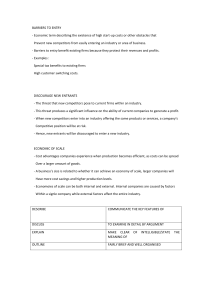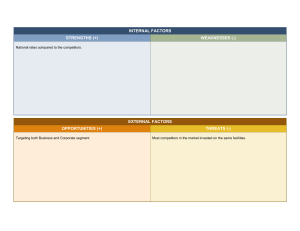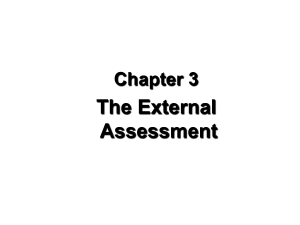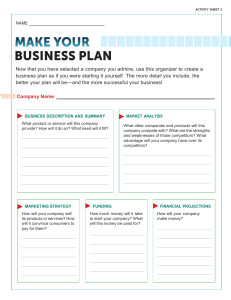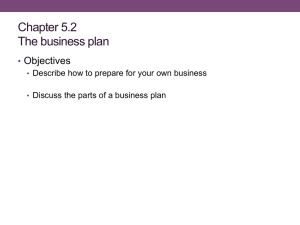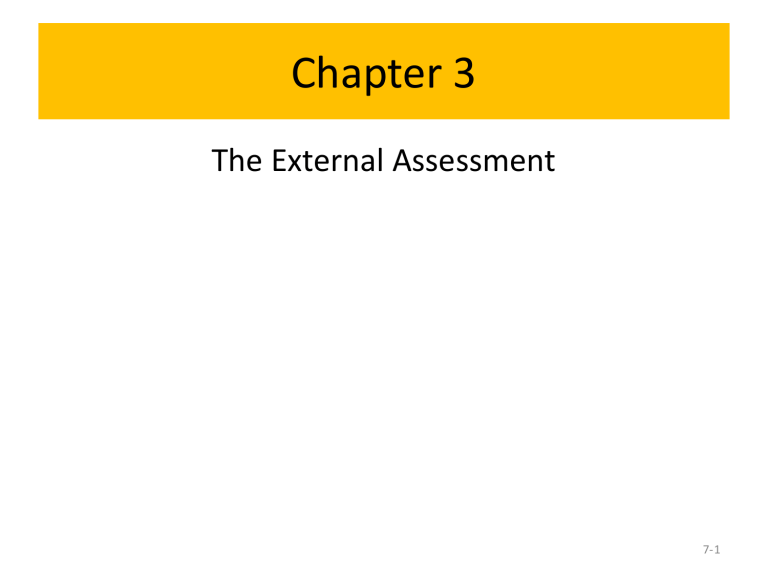
Chapter 3 The External Assessment 7-1 Learning Objectives 1. Describe the nature and purpose of an external assessment in formulating strategies. 2. Identify and discuss 10 external forces that must be examined in formulating strategies: economic, social, cultural, demographic, environmental, political, governmental, legal, technological, and competitive. 3. Explain Porter’s Five Forces Model and its relevance in formulating strategies. 7-2 Learning Objectives (cont.) 4. Describe key sources of information used for locating vital external information. 5. Discuss forecasting tools and techniques. 6. Explain how to develop and use an External Factor Evaluation (EFE) Matrix. 7. Explain how to develop and use a Competitive Profile Matrix. 7-3 External Audit ❖ External audit ❖ focuses on identifying and evaluating trends and events beyond the control of a single firm ❖ reveals key opportunities and threats confronting an organization so that managers can formulate strategies to take advantage of the opportunities and avoid or reduce the impact of threats 7-4 The Nature of an External Audit ❖ The external audit is aimed at identifying key variables that offer actionable responses ❖ Firms should be able to respond either offensively or defensively to the factors by formulating strategies that take advantage of external opportunities or that minimize the impact of potential threats. 7-5 Key External Forces External forces can be divided into five broad categories: 1. economic forces 2. social, cultural, demographic, and natural environment forces 3. political, governmental, and legal forces 4. technological forces 5. competitive forces 7-6 Relationships Between Key External Forces and an Organization 7-7 The Process of Performing an External Audit ❖ First, gather competitive intelligence and information about economic, social, cultural, demographic, environmental, political, governmental, legal, and technological trends. 7-8 The Process of Performing an External Audit ❖ Information should be assimilated and evaluated ❖ A final list of the most important key external factors should be communicated 7-9 The Industrial Organization (I/O) View ❖ The Industrial Organization (I/O) approach to competitive advantage advocates that external (industry) factors are more important than internal factors in a firm for gaining and sustaining competitive advantage. 7-10 Economic Forces ❖ ❖ ❖ ❖ ❖ ❖ ❖ ❖ ❖ ❖ ❖ ❖ Shift to service economy Availability of credit Level of disposable income Propensity of people to spend Interest rates Inflation rates GDP trends Consumption patterns Unemployment trends Value of the dollar Import/Export factors Demand shifts for different goods and services ❖ Income differences by region and consumer group ❖ Price fluctuations ❖ Foreign countries’ economic conditions ❖ Monetary and Fiscal policy ❖ Stock market trends ❖ Tax rate variation by country and state ❖ European Economic Community (EEC) policies ❖ Organization of Petroleum Exporting Countries (OPEC) policies 7-11 Advantages of a Strong Dollar 1. 2. 3. 4. 5. 6. 7. 8. 9. 10. Leads to lower exports Leads to higher imports Makes U.S. goods expensive for foreign consumers Helps keep inflation low Allows U.S. firms to purchase raw materials cheaply from other countries Allows U.S. to service its debt better Spurs foreign investment Encourages Americans to travel abroad Leads to lower oil prices because oil globally is priced in U. S. dollars Encourages Americans to spend money because they can buy more for their money 7-12 Social, Cultural, Demographic, and Natural Environmental Forces ❖ U.S. Facts ❖ ❖ ❖ ❖ Aging population Less white 2050 = 20% population > 65 years 2075 = no ethnic or racial majority 7-13 Key Social, Cultural, Demographic, and Natural Environmental Variables ❖ Population changes by race, age, and geographic area ❖ Regional changes in tastes and preferences ❖ Number of marriages ❖ Number of divorces ❖ Number of births ❖ Number of deaths ❖ Immigration and emigration rates ❖ Social Security programs ❖ Life expectancy rates ❖ Per capita income ❖ Social media pervasiveness ❖ Attitudes toward retirement ❖ Energy conservation ❖ Attitudes toward product quality ❖ Attitudes toward customer service ❖ Pollution control ❖ Attitudes toward foreign peoples ❖ Energy conservation ❖ Social programs ❖ Number of churches ❖ Number of church members ❖ Social responsibility issues 7-14 Political, Governmental, and Legal Forces ❖ The increasing global interdependence among economies, markets, governments, and organizations makes it imperative that firms consider the possible impact of political variables on the formulation and implementation of competitive strategies. 7-15 Political, Government, and Legal Variables ❖ Environmental regulations ❖ Number of patents ❖ Changes in patent laws ❖ Equal employment laws ❖ Level of defense expenditures ❖ Unionization trends ❖ Antitrust legislation ❖ USA vs. other country relationships ❖ Political conditions in foreign countries ❖ Global price of oil changes ❖ Local, state, and federal laws ❖ Import–export regulations ❖ Tariffs ❖ Local, state, and national elections 7-16 Technological Forces New technologies such as: ❖ the Internet of Things ❖ 3D printing ❖ the cloud ❖ mobile devices ❖ biotech ❖ analytics ❖ autotech ❖ robotics and ❖ artificial intelligence are fueling innovation in many industries, and impacting strategic-planning decisions. 7-17 Technological Forces ❖ Many firms now have a Chief Information Officer (CIO) and a Chief Technology Officer (CTO) who work together to ensure that information needed to formulate, implement, and evaluate strategies is available where and when it is needed 7-18 Results of Technological Advances 1. Major opportunities and threats that must be considered in formulating strategies. 2. Can affect organizations’ products, services, markets, suppliers, distributors, competitors, customers, manufacturing processes, marketing practices, and competitive position. 3. Can create new markets, result in new and improved products, change the relative competitive cost positions, and render existing products and services obsolete. 4. Can reduce or eliminate cost barriers between businesses, create shorter production runs, create shortages in technical skills, and result in changing values and expectations of employees, managers, and customers. 5. Can create new competitive advantages that are more powerful than existing advantages. 7-19 Competitive Forces ❖ An important part of an external audit is identifying rival firms and determining their strengths, weaknesses, capabilities, opportunities, threats, objectives, and strategies 7-20 Competitive Forces Characteristics of the most competitive companies: 1. 2. 3. 4. 5. 6. 7. Strive to continually increase market share Use the vision/mission as a guide for all decisions Whether it's broke or not, fix it–make it better Continually adapt, innovate, improve Acquisition is essential to growth Hire and retain the best employees and managers possible Strive to stay cost-competitive on a global basis 7-21 Key Questions About Competitors 1. 2. 3. 4. 5. 6. 7. 8. 9. 10. 11. 12. What are the strengths of our major competitors? What are the weaknesses of our major competitors? What are the objectives and strategies of our major competitors? How will our major competitors most likely respond to current economic, social, cultural, demographic, environmental, political, governmental, legal, technological, and competitive trends affecting our industry? How vulnerable are the major competitors to our alternative company strategies? How vulnerable are our alternative strategies to successful counterattack by our major competitors? How are our products or services positioned relative to major competitors? To what extent are new firms entering and old firms leaving this industry? What key factors have resulted in our present competitive position in this industry? How have the sales and profit rankings of our major competitors in the industry changed over recent years? Why have these rankings changed that way? What is the nature of supplier and distributor relationships in this industry? To what extent could substitute products or services be a threat to our competitors? 7-22 Competitive Intelligence Programs ❖ Competitive intelligence (CI) ❖ a systematic and ethical process for gathering and analyzing information about the competition's activities and general business trends to further a business's own goals 7-23 Competitive Intelligence Programs The three basic objectives of a CI program are: 1. To provide a general understanding of an industry and its competitors 2. To identify areas in which competitors are vulnerable and to assess the impact strategic actions would have on competitors 3. To identify potential moves that a competitor might make that would endanger a firm's position in the market 7-24 The Five-Forces Model of Competition 7-25 The Five-Forces Model of Competition 1. Identify key aspects or elements of each competitive force that impact the firm. 2. Evaluate how strong and important each element is for the firm. 3. Decide whether the collective strength of the elements is worth the firm entering or staying in the industry. 7-26 The Five-Forces Model ❖ Rivalry among competing firms ❖ Most powerful of the five forces ❖ Focus on competitive advantage of strategies over other firms 7-27 The Five-Forces Model TABLE 7-7 Conditions That Cause High Rivalry Among Competing Firms ▬▬▬▬▬▬▬▬▬▬▬▬▬▬▬▬▬▬▬▬▬▬▬▬▬▬▬▬▬▬▬▬▬▬▬▬▬▬ 1. When the number of competing firms is high 2. When competing firms are of similar size 3. When competing firms have similar capabilities 4. When the demand for an industry’s products is falling 5. When the product or service prices in the industry are falling 6. When consumers can switch brands easily 7. When barriers to leaving the market are high 8. When barriers to entering the market are low 9. When fixed costs are high among competing firms 10. When the product is perishable 11. When rivals have excess capacity 12. When consumer demand is falling 13. When rivals have excess inventory 14. When rivals sell similar products/services 15. When mergers are common in the industry 7-28 The Five-Forces Model ❖ Potential Entry of New Competitors ❖ Barriers to entry are important ❖ Quality, pricing, and marketing can overcome barriers 7-29 Barriers to Entry ❖ Need to gain economies of scale quickly ❖ Need to gain technology and specialized knowhow ❖ Lack of experience ❖ Strong customer loyalty ❖ Strong brand preferences ❖ Large capital requirements ❖ Lack of adequate distribution channels 7-30 Barriers to Entry ❖ ❖ ❖ ❖ ❖ ❖ ❖ Government regulatory policies Tariffs Lack of access to raw materials Possession of patents Undesirable locations Counterattack by entrenched firms Potential saturation of the market 7-31 The Five-Forces Model ❖ Potential development of substitute products ❖ Pressure increases when: ❖ Prices of substitutes decrease ❖ Consumers' switching costs decrease 7-32 The Five-Forces Model ❖ Bargaining Power of Suppliers is increased when (there are): ❖ Few suppliers ❖ Few substitutes ❖ Costs of switching raw materials is high ❖ Backward integration is gaining control or ownership of suppliers 7-33 The Five-Forces Model ❖ Bargaining power of consumers ❖ Customers being concentrated or buying in volume affects intensity of competition ❖ Consumer power is higher where products are standard or undifferentiated 7-34 Conditions Where Consumers Gain Bargaining Power 1. If buyers can inexpensively switch 2. If buyers are particularly important 3. If sellers are struggling in the face of falling consumer demand 4. If buyers are informed about sellers' products, prices, and costs 5. If buyers have discretion in whether and when they purchase the product 7-35 Sources of External Information ❖ Unpublished sources include customer surveys, market research, speeches at professional and shareholders' meetings, television programs, interviews, and conversations with stakeholders. ❖ Published sources of strategic information include periodicals, journals, reports, government documents, abstracts, books, directories, newspapers, and manuals. 7-36 Sources of External Information ❖ http://finance.yahoo.com ❖ www.hoovers.com ❖ http://globaledge.msu.edu/industries/ 7-37 Forecasting Tools and Techniques ❖ Forecasts ❖ educated assumptions about future trends and events ❖ no forecast is perfect 7-38 Making Assumptions ❖ Assumptions ❖ Best present estimates of the impact of major external factors, over which the manager has little if any control, but which may exert a significant impact on performance or the ability to achieve desired results. 7-39 Business Analytics ❖ Using software to mine huge volumes of data ❖ Helps executives make decisions 7-40 Industry Analysis: The External Factor Evaluation (EFE) Matrix Summarize and evaluate these factors: ❖ Economic ❖ Political ❖ Social ❖ Governmental ❖ Cultural ❖ Legal ❖ Demographic ❖ Technological ❖ Environmental ❖ Competitive 7-41 EFE Matrix Steps 1. List 20 key external factors 2. Weight from 0.0 to 1.0 3. Rate the effectiveness of current strategies from 1-4 4. Multiply weight * rating 5. Sum weighted scores 7-42 EFE Matrix for a Local Ten-Theater Cinema Complex 7-43 Industry Analysis: Competitive Profile Matrix (CPM) ❖ Identifies firm's major competitors and their strengths & weaknesses in relation to a sample firm's strategic positions ❖ Critical success factors include internal and external issues 7-44 An Example Competitive Profile Matrix TABLE 7-12 An Example Competitive Profile Matrix ▬▬▬▬▬▬▬▬▬▬▬▬▬▬▬▬▬▬▬▬▬▬▬▬▬▬▬▬▬▬▬▬▬▬▬▬▬▬▬▬▬ Company 1 Company 2 Company 3____________ Critical Success Factors_ ___ _ Weight Rating Score Rating Score Rating Score____ ____ Advertising 0.20 1 0.20 4 0.80 3 0.60 Product Quality 0.10 4 0.40 3 0.30 2 0.20 Price Competitiveness 0.10 3 0.30 2 0.20 1 0.10 Management 0.10 4 0.40 3 0.20 1 0.10 Financial Position 0.15 4 0.60 2 0.30 3 0.45 Customer Loyalty 0.10 4 0.40 3 0.30 2 0.20 Global Expansion 0.20 4 0.80 1 0.20 2 0.40 Market Share 0.05 1 0.05 4 0.20 3 0.15 Total 1.00 3.15 2.50 2.20 Note: The ratings values are as follows: 1 = major weakness, 2 = minor weakness, 3 = minor strength, 4 = major strength. As indicated by the total weighted score of 2.50, Competitor 2 is weakest. Only eight critical success factors are included for simplicity; this is too few in actuality. 7-45
